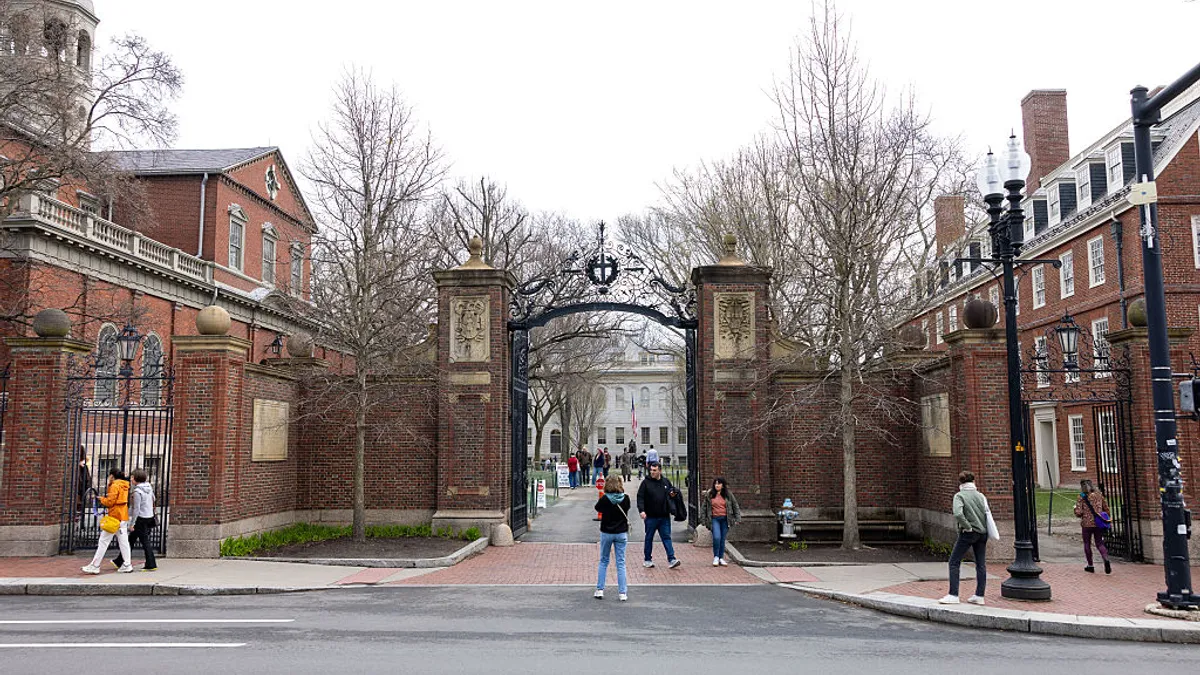Editor's note: This is the first article in a three-part series about the current and future state of student employment on college campuses. Read the second article here and the third article here.
A familiar chunk of financial aid, work-study has for years slid job-hungry students into easy-to-learn and fluid positions that colleges might otherwise struggle to fill, especially so inexpensively. It even sometimes bridges the gap with the business community or encourages students to connect with the people who make their college work. And in many cases, the federal or state government foots at least half the bill.
But new research from several quarters suggests the Federal Work-Study (FWS) program's cranky, decades-old funding formula is unfair and unworkable, and that students should get more out of the experience than they currently do.
That is especially true in an economy in which the practical value of college is continually scrutinized and businesses are clamoring for job-ready graduates with hard and soft skills that they've honed through work experience.
Some question whether FWS jobs actually go to students with the greatest need, and critics of the program contend those hour- and salary-restricted positions often don't pay enough. Those problems are often true of non-FWS campus jobs, too, contributing to a broad push to add value to the types of employment colleges offer students.
"Work-study programs for some time have not gotten a lot of attention, but that's changing," said Iris Palmer, a senior education policy analyst at New America, a Washington, D.C.-based think tank, who has studied and written about work-study. On campuses and in Washington, she said, new ideas for student employment are emerging, along with the momentum for change.
Federal Work-Study today
The desire to prepare students for careers and improve their financial security are the two biggest reasons colleges offer work-study programs, according to a recent report by NASPA-Student Affairs Administrators in Higher Education that was based on a survey of 244 institutions as well as interviews with campus officials and site visits. Two-thirds of colleges also said they hope it will improve retention/completion and student connections to campus.
FWS employed about 600,000 undergraduate and graduate students during the 2017-18 school year, and it makes up a varying portion of campus employment. It is the largest source of student employment funding for two-thirds of public two-year colleges, according to NASPA. And more than one-third of private nonprofit four-year colleges and one-fourth of public four-years say it is their largest source.
Meanwhile, department funds made up nearly half of financial support for student employment at public four-year colleges. A similar share of institutional funding footed the bill at private nonprofit four-year institutions.
The roughly $1 billion FWS currently gets in funding is only about 3% of the amount provided for the separate Pell Grant program, according to data compiled by the Urban Institute. That's down from 7% of Pell dollars in 2007-08 and 13% in 1997-98.
There is limited support for work-study at the state level. A 2014 report from the Working Poor Families Project, which advocates for workforce development policies, found that roughly 14 states fund and administer work-study in colleges. It also noted that some program funds had been cut dramatically as states tightened their belts as a result of the recession.
Developing a funding source separate from a state's politically sensitive general fund could help, the report contends. It notes that a handful of states have done so already.
New sources of funding
A mix of support for on-campus employment has become more important as students' relationships with work during college changes. Over the last few decades, the rising cost of attendance has meant the minimum-wage and summer jobs that students have long relied on don't yield enough to cover tuition and other expenses.
A report last year from the Georgetown University Center on Education and the Workforce (CEW) notes that seven in 10 college students work at least 15 hours per week, and one in four work more than 35 hours.
What's more, low-income students are more likely to work longer hours and in jobs unrelated to their professional goals or academic studies, and critics say FWS doesn't do enough to provide them with a more focused alternative even though that's its stated objective.
Data show the FWS funding formula, which is based on how long institutions have participated in the program and their students' levels of need, unfairly benefits older, pricier colleges, said Sandy Baum, a nonresident fellow at the Urban Institute and author of a new report on FWS.
NASPA didn't find enough evidence to suggest FWS positions had more or less value to students than institution-funded positions. "We found that the only meaningful difference between the two is the funding source," said Alexa Wesley, a research and policy associate with the association and a co-author of its report.
"Work-study programs for some time have not gotten a lot of attention, but that's changing."

Iris Palmer
Senior policy analyst, New America
FWS does limit how much a student can work, however. That can impact their earnings and, in turn, the program's relevance to them. NASPA's report found that most (70%) student employees across institutions worked 15 hours or less each week and nearly all the rest (96%) worked up to 20 hours.
For perspective, a separate Georgetown CEW report, published in 2015, noted that a student who works full-time and earns the federal minimum wage would bring in just over $15,000 per year, before taxes. Tuition prices alone, meanwhile, range from an average of about $10,000 per year at public in-state institutions to $36,000 at private colleges.
However, working more can negatively impact a student's academic performance, the NASPA report found. The impact becomes apparent when students begin working between 16 and 25 hours weekly. Students at public two- and four-year institutions were more likely to work more than 15 hours per week than those at private nonprofits.
Creating positions of value
Another common criticism of FWS is that the positions it offers often aren't related to students' academic interests, don't challenge them or offer new training, and generally miss an opportunity for career development.
"This is, in theory, a program that could provide students with paid, career-oriented work experiences that they often aren't getting currently," said Reid Setzer, co-author of an ambitious 2014 report on ways to reform FWS for the student advocacy group Young Invincibles.
Setzer, who is now director of government affairs at The Education Trust, along with other experts who follow work-study, say political momentum could help drive more spending on FWS, instigate changes to its funding formula and implement new rules to make the jobs more valuable to students.
NASPA's report found the areas of the institution that hire the most student employees are: student life and student affairs, recreation services and the fitness center, and residential life.
Those who advocate for more comprehensive student employment also seek partnerships with industry through internships and apprenticeships. That's something the Trump administration has championed.
New America's Palmer said colleges are testing new approaches, particularly with apprenticeships, which the think tank strongly encourages. Harper College, in Palatine, Illinois, has been a leader among community colleges in the development of apprenticeships, she noted. The program began in 2015 with a $2.5 million U.S. Department of Labor grant. As of last fall, it had expanded to eight programs and placed 158 students as apprentices.
"Unfortunately, one of the big issues with off-campus student employment is the administration of it," Palmer said. "That is a huge barrier, although I think most people agree that such arrangements bring value to student work experiences."
Colleges may be reluctant to lose the lower-cost workers under FWS to private firms, Baum said. And institutions often struggle to develop those opportunities, some observers say, or they don't have the time or funds to find and administer them.
"This is, in theory, a program that could provide students with paid, career-oriented work experiences that they often aren't getting currently."

Reid Setzer
Co-author, "A Federal Work Study Reform Agenda to Better Serve Low-Income Students"
Christian Corrales, director of on-campus student employment at the University of Texas at El Paso (UTEP), oversees some 3,300 student jobs, including 150 funded by the university, 400 through work-study and the remaining through UTEP's departments.
The effort, which is part of a broader experiential learning program called UTEP Edge, is designed to develop more meaningful positions that teach students useful skills and relate to their academic interests.
In line with several recommendations from NASPA, UTEP Edge rounds out students' experience with other elements of employment, such as being interviewed and undergoing a formal evaluation based on established job expectations. Supervisors can also recommend students for professional development programs at the university.
"The day-to-day job may still be somewhat routine, but there are opportunities for students to learn about the world of work," Corrales said. "We want our student employees to gain as much of that sort of experience as they can."
NASPA recommends work-study and similar positions include a "learning framework" that outlines the knowledge and skills students will develop on the job and how they connect to other learning experiences. (Only 37% of the institutions it surveyed said they have or are developing one.) Various supports for supervisors through a centralized office are also recommended.
Colleges should evaluate their student employment programs regularly. To help, NASPA developed a self-assessment rubric they can use to improve them or develop new initiatives.
"Institutions should take stock of their current efforts to understand not only who their students are and what they need from an employment experience, but also areas of strength, existing assets and areas of limitation or improvement," Wesley said.




















